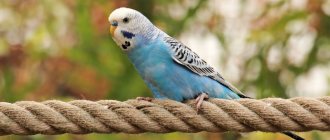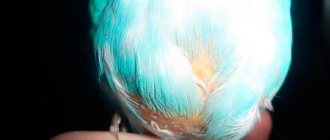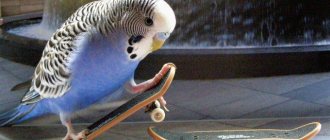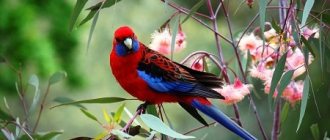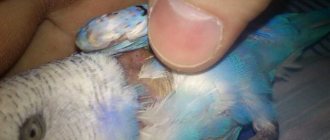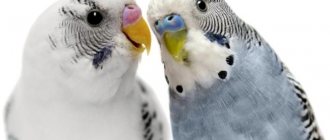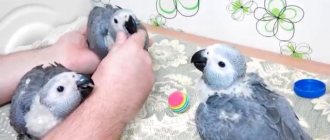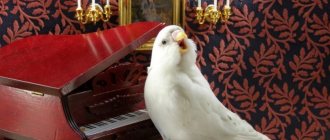Many people choose medium-sized parrots as pets. These birds are distinguished by their relatively small size and beauty, thanks to which they can be successfully kept in a small-sized city apartment. Medium-sized parrots have many genera and species. In our article we will try to briefly highlight the most common breeds of medium-sized parrots found in captivity.
Corella
Corella is a close relative of the cockatoo. In nature, this species is found in Australia and is prohibited from being caught and exported, but it is kept in captivity and bred by hobbyists all over the world. Among all the medium-sized parrots, the cockatiel is the most widespread species in captivity. This is due to the ease of its maintenance and breeding, as well as its affordable price.
The size of the cockatiel reaches 30-33 cm, body weight - 90-100 g. There is a long crest on the head. Natural color is gray with white areas on the wings. The head and crest are yellow, with large orange spots on the cheeks. Females are paler in color than males. During the selection process, other color options were obtained: white, light yellow, brown, spotted.
Traditional plastic carrier
Perhaps the most common way to move small animals. Very well suited for long-distance travel, but in a car (and especially on a bicycle) a bulky plastic box is not very convenient.
Among the advantages, we note excellent breathability, ease of cleaning and maintenance, the ability to organize meals while traveling, hygiene, strength and durability.
The disadvantages are determined by the need to allocate space for storing this box and, of course, the outdated design. It is necessary to have such a device in stock, but it is not very suitable for short-term forays outside the city.
Cost – 1,146 – 2,137 rubles.
Ruffled parrot
The Ruffed Parakeet is a medium-sized parrot kept in captivity by bird lovers around the world. The natural range is limited to a number of areas in Africa and South Asia, but due to its ability to adapt to cold climates, the species has formed secondary wild populations in some regions of Europe and the USA.
The body length of the necklace parrot reaches 40-42 cm, weight - 115-140 g. Natural color is bright green; the wings, tail and back have a bluish tint. Breeders have bred blue, yellow, white and variegated morphs. The beak is large, bright red. A narrow black stripe shaped like a “necklace” runs from the bottom of the beak around the neck. Females do not have this stripe.
In nature, necklace parrots live in colonies of several dozen individuals. In captivity they are kept singly or in pairs. Birds are well tamed and remember human speech.
Main care questions
— Do parrots need to be vaccinated? “Parrots are not vaccinated by veterinarians,” says Oleg Rosenberg, a teacher at the veterinary and zoology club at the Minor Academy of Sciences. — If a bird lives in an outdoor enclosure and has contact with wild birds, then you need to buy a vaccine against Newcastle disease at the pharmacy. Take one dose and add it to the bird’s water. The vaccine should be given once a year. If the parrot lives in an apartment, no vaccine is needed.
In summer, expose the bird to direct sun every day for 20 minutes; this will help prevent rickets, which occurs due to a lack of vitamin D in the body.
— What to feed birds? — Parrots are fed with special food, which is sold in pet stores. As for treats, everything is individual, you need to try different options and see what your pet likes best. If we talk about small breeds, some love seeds, others millet and dried fruits, large breeds love walnuts and fruits.
For parrots that sit in cages for a long time, bring branches of fruit trees (cherries, plums) with buds that have not been treated with chemicals. Parrots will gnaw buds and bark and grind down their beak.
- What kind of water can you give? - Regular boiled water.
— How much time should you devote to the bird? — At least an hour a day. If you have several birds, then you need to communicate with each of them separately. Parrots are social birds. If you don’t spend time with them, and only with them, without being distracted by anyone else in the family, your pet may get sick.
— Is it possible to have a parrot if there is already a cat at home? — If you let a small parrot fly, it will become a target for the cat. The exception is if they grew up together. In this case, the cat will perceive the same budgerigar as a home interior. The cat will not attack large parrots (Grey, Amazon), because they are large and can peck painfully.
— Do you need to bathe a parrot and how to care for them? — You don’t need to forcefully bathe a parrot. Place the bathing suit in the cage, and when the bird wants, then he will take a bath. Birds need their claws trimmed. You can do this yourself at home. Buy a nail clipper (ordinary scissors will not work), and watch several video tutorials on the Internet. It clearly shows at what angle the claws should be trimmed.
— How to choose a cage? — The cage must be spacious so that the parrot can fly in it. It is necessary that at a minimum the bird can make 4 wing strokes from the perch (the place where it will sit) to the perch. In this case, the wing muscles will work well, and the parrot will be comfortable with you.
Large parrots, such as Grays and Amazons, need more space. An enclosure measuring approximately one meter by one meter from floor to ceiling will suit them.
— Should I let my parrot fly around the house? — A parrot shouldn’t fly around the apartment all the time. In 90% of cases, the death of these birds occurs due to the fact that they are released for a walk. Parrots do not navigate the terrain; when they fly out of the cage, they immediately get lost. If you still decide to let him out, close the windows in the room with curtains. Parrots often hit glass when they accelerate. In addition, the parrot can sit on the door, and if it closes due to a draft, the bird will pinch its paws - consider that you have lost it. Finally, your pet may fly into the kitchen, fall into boiling soup, or, out of curiosity, peck at salt, which is poison for birds.
Be prepared for the fact that parrots will try everything with their beaks: they will chew wallpaper, decorative elements, and wiring.
— What can scare a parrot? - Under no circumstances should you grab his paws without allowing him to move. The bird may die of fear. For a bird, flight is a normal, natural state. The parrot must feel that it can fly away from danger at any moment. If you immobilize him, adrenaline is released, and the heart cannot stand it.
If a parrot was flying and suddenly landed on your shoulder or scratched you, do not flinch. You can't shout or wave your arms. This is perceived as aggression and can frighten the pet.
Laurie
Lories are a subfamily of parrots, numbering 12 genera, which include 62 species. These birds are found in Australia, Indonesia, New Guinea and the Philippines. Lorises are not shy, quickly become tamed and become attached to their owners, and are able to remember words and phrases.
The size of the loris, depending on the species, can reach from 18 to 35 cm. These parrots are brightly colored; most often the plumage is dominated by green, red, blue and yellow shades. The tongue of the loris has the shape of a brush, which is associated with the feeding habits of these birds.
Lorises feed on nectar, juicy fruits and berries. In captivity, the diet of these birds should consist mainly of liquid and succulent food: fruits, vegetables, flowers, pollen, nectar, freshly squeezed juices, syrups and honey diluted with water, and special gruels. This diet contributes to rapid contamination of the cage, so cleaning the loris must be done daily.
What do budgies eat?
According to scientists, the basis of the diet of budgerigars in nature is the seeds of land plants, mostly the seeds of kangaroo grass. Due to human intervention in natural habitats, birds are forced to adjust their diet depending on changes in environmental conditions. Today, Australia's main grain crop grown throughout the world is wheat, but the grains are too large for small birds. In addition to grains, budgies eat young shoots and leaves of plants, various berries, vegetables and fruits, and occasionally feed on insects and other invertebrates.
Rosella
Rosellas are medium-sized parrots native to Australia and Tasmania. They are well tamed and become attached to humans. These parrots are characterized by a jealous attitude towards their owner, as a result of which they can show aggression towards other poultry. Rosellas are poorly trained in human speech and usually remember no more than 5-10 words, but they are able to reproduce various melodies and the singing of other birds. They have a quiet and pleasant voice.
The body length of rosellas reaches 30 cm, weight - 80-130 g. The plumage is bright: the body is yellow-green, the head and chest are bright red, the cheeks are white, the wings and tail are blue-green with black, the undertail is red, the back feathers are black with a wide yellow -green border. Females are paler in color. Rosellas are kept in a spacious cage or enclosure. Birds cannot tolerate high temperatures and humidity, but adapt well to cold.
Kea
Another peculiar parrot that lives in New Zealand is the kea or nestor. The main habitat is beech forests and bushes in the mountainous areas of the South Island. The Nestor is similar in size and appearance to a crow. Sometimes an individual grows up to half a meter in length and gains a mass of more than a kilogram. Feathers the color of ripe olives cover the top of the body, and in flight the bright shades of the inner side of the wings are revealed.
Why is this species interesting? Kea are famous for their sharp mind and mischievous nature, they play pranks on the verge of crime:
- approach tourist centers and damage property;
- steal food, accessories and equipment;
- dump trash containers.
The curiosity of parrots knows no bounds; for entertainment, they even gather in groups and lie in wait for people, begging for treats. In bad weather, when the wind blows, kea love to demonstrate the wonders of acrobatics, again for this they need spectators.
The unpleasant activity of these brown pests previously included the fact that they attacked sick and lost sheep. An animal that strayed from the herd was subjected to a brutal attack by birds of prey, which sat on its back and pecked the subcutaneous fat. In a fit of vengeance, farmers began to exterminate the vandal birds, which almost led to the extinction of the species. Now ornithologists are intensively restoring the number of kea, these parrots are protected by law.
Parrot monk
The monk parrot is a medium-sized bird that naturally lives in South America. Populations of secondarily feral parrots are found in the USA and some European countries (Italy, Greece, the Netherlands, Great Britain, Belgium). Monk parakeets live in flocks of up to several hundred individuals. Unlike other species of parrots, monks nest not in hollows, but directly on tree branches. In this case, several pairs of birds build one large nest with many internal chambers and exits.
The body length of monks reaches 27-30 cm, weight - 100 g. The plumage is green, the wings are blue, the forehead and chest are silver. The beak is powerful, pinkish in color. Due to their resistance to low temperatures, monks can be kept in outdoor enclosures during the warm season. These birds are very sociable, quickly tamed, easy to train, remember words and phrases, as well as melodies.
What types of domestic parrots are there?
The most common breeds that are domesticated by humans are:
- - wavy
- - cockatiels
- - cockatoo
- - gray
- - lovebird
- - macaw
The budgerigar is an extremely common domesticated bird and the smallest parrot. It will be an excellent companion for almost any child or adult. He also reacts well to people, quickly tames, makes contact with pleasure, and easily remembers words.
Oddly enough, in their homeland, Australia, wild budgies replace pigeons. Australian "pigeons" are distributed throughout almost the entire continent. “Real” budgies are only green-yellow in color; all other shades and colors were obtained through artificial selection. “Volnushki” live in colossal flocks in the wild - up to several thousand individuals.
Colonies of wild budgerigars in the wild
Moreover, the socialization of these birds has reached such heights that the flock is a huge well-coordinated mechanism that works without failures - each individual knows its functionality and place during the flight. Ornithologists are still racking their brains about how such a small bird, it would seem, manages to do something that is beyond the control of the human mind?
In the wild, budgies feed throughout the day and like to settle near rivers and ponds. Despite the fact that at home they can memorize up to 30 words, in their natural environment they only need 9 sounds to communicate with each other.
In nature, wavy birds live in flocks
Cockatiels are a medium-sized species of parrot. They are quite peaceful and not too loud (although it is worth noting that at an early age it is almost impossible to silence them - at this time they realize that they have a very melodious and ringing voice, which they cannot wait to put into practice). In addition, these cute pets quickly adapt to their environment and train well. Previously, they were considered a subspecies of cockatoos, but have now been identified as a separate subspecies. Cockatiels make contact with people, but do not learn tricks and speaking well.
If you ask what large parrots are called, we can give the following breeds as an example:
Macaw
Macaws are one of the most expensive species that can be purchased legally. Large, smart, independent. A funny feature is the fact that their mood can be understood by the skin around their eyes. If a macaw is angry or excited, it changes color to red or orange.
Fans of exotics need to understand that keeping a macaw in an apartment can cause headaches not only for the owners, but also for the neighbors: this species has a loud and rather unpleasant voice that can infuriate anyone.
They are quite noisy and not every person can get used to their harsh timbre of voice. This species, although it does not have the ability to learn words, is very amenable to learning various funny tricks.
Cockatoo
The cockatoo is a noticeable bird (weight can reach 1 kg) and serious in size. This is a large parrot, most often white in color. It can safely be classified as a long-livers (there are known individuals whose age is 100 years). Thanks to their energy and remarkable ingenuity, these birds win the well-deserved love of their owners.
It is worth knowing that the beak of this species is very powerful and it is capable of breaking shells, wooden sticks up to a centimeter thick, and even metal wire. Cockatoos are very loving and constantly show their tenderness towards a person, jealously protecting him from the encroachments of other pets - dogs, cats and even other parrots
Cockatoos love to socialize, dance, and play—these birds will do whatever it takes to get attention and praise.
Jaco
Jaco can rightfully be called the most talented representative of the squad. He easily becomes attached to the people around him. Grays are a medium-sized breed of parrots. They easily learn not only individual words, but even entire sentences. They have a pleasant gray color and an aristocratic appearance.
Lovebirds
Lovebirds can be classified as small representatives. There is an opinion that birds of the same pair are strongly attached to each other and are always together (although there are cases when the pair quickly broke up and the parrots needed to look for new partners). They have a calm and cheerful disposition, although they are not talkative.
Caique
The caique is a breed of medium-sized parrot native to South America. Birds are well tamed and amenable to training; They are able to repeat heard melodies and sounds, but cannot imitate human speech.
The body length of parrots usually does not exceed 25 cm, weight - 150 g. There are two types of caiques: black-headed and red-headed. The body color of both species is orange-yellow, the chest is white, the back, wings and tail are green. The black-headed caique has a black upper part of its head; The redhead has an entirely yellow-orange head.
Caiques are extremely active birds. They require a spacious enclosure in which they can fly. It should be equipped with toys and climbing aids. Caiques cannot tolerate the presence of other bird species; if kept together, fights will begin between them.
Wavy
We would like to finish the material about which parrots talk with a description of one of the most popular pets - the budgerigar (lat. Melopsittacus undulatus). In addition, it can safely be included in the list of smart parrots.
Budgerigars can distinguish colors and 150 images per second, and hear sounds in the range of 400–2000 hertz. They can be taught to count to three and speak about 100 words.
Although, unlike their large relatives, budgerigars do not speak very clearly. The owners can teach them to recite simple children's quatrains. They can tell them exactly, or they can change phrases. Boys learn words better than girls.
There is practically no need to care for budgies. They adapt well and quickly to a new environment. They have a good, good-natured character. They learn easily, love to fly and play. They are cheerful, constantly chirping sweetly, and love communication. The person is friendly.
Budgerigars grow up to 19 cm in height. Their plumage can be completely varied—about 200 colors have been developed. The main color is green with a yellow head and throat. The back of the head is covered with dark wavy lines.
Budgerigars have a powerful beak that can carry various objects.
The homeland of this breed is Australia.
The lifespan of these pets is 10–15 years.
The cost of a budgie starts at $20.
So, now you know which parrot is the most talkative. And if you are still not afraid of noise and feathers in the house, and you are serious about purchasing a pet, then you should take care of decent living conditions for it. If you have not previously had experience communicating with and caring for birds, then we advise you to opt for cockatiels or budgies - keeping them is not difficult, they are excellent students and wonderful imitators.
In the case when you have already learned how to care for birds, you can consider the option of larger birds, for example, Gray, Macaw, Eclectus, Rosella. However, be prepared that the cost of these birds will also be much higher.
Aratinga
Aratinga is a genus of parrots that includes 22 species. Aratingas inhabit Central and South America. The body size of birds, depending on the species, reaches 25-33 cm, weight - 100-110 g. The plumage is bright, most often the colors are yellow, orange and green.
The level of intelligence of these parrots is quite high. They are easily tamed, amenable to training, and remember melodies, sounds, words and phrases. Thanks to their natural agility, they can be trained to perform complex tricks.
Aratingas are non-aggressive and can get along in the same enclosure with other bird species. Parrots should have enough space for flying and active movement. To prevent the aratinga from getting bored, a variety of toys and puzzles are placed in the enclosure. In the wild, aratingas like to shower by shaking dew from tree branches. In captivity, birds are regularly sprayed with warm water from a spray bottle or a bathing suit is placed in the enclosure.
Drinking fountain
Such a device can serve not only to quench the thirst of animals, but also become an original accent in the home interior. The design consists of a water bowl, a filter, a diffuser and a drinking bowl located at the top. Additionally, it is equipped with a decorative sprinkler, especially popular with native breeds (Maine Coons, Kuril Bobtails, Siberian cats).
Continuous circulation of liquid is ensured by a mini-pump powered by a USB cable. More advanced models may contain backlighting and an indication of the level of remaining water in the tank.
Cost – 2400 rub.
Content Features
Conditions in captivity are similar for all species of medium-sized parrots. A comfortable temperature for birds is +20°C; many species tolerate cold well, and therefore can be moved to outdoor enclosures for the summer. At the same time, it is important to prevent the birds from overheating and equip the aviary with canopies from the sun.
Aviary keeping is not only convenient, but also beneficial for the health of birds. Some species of parrots do not reproduce in cage conditions, but when kept in an aviary, it is not difficult to get offspring from them.
If the owner does not have the goal of obtaining offspring, parrots can be kept in apartment conditions without any problems. For permanent indoor living, a spacious cage or aviary is suitable. The size of the home should allow the parrot to freely spread its wings and fly from perch to perch. The average size of a cage for one bird is 80x60x60 cm. The following is placed in the cage:
- hardwood perches;
- climbing equipment – ropes, ladders, swings;
- toys;
- feeders - for dry and wet food;
- drinking bowl
The water in the drinking bowl is changed daily. Parrots need to be bathed regularly to maintain their plumage in proper condition, so place a bathing suit in the cage or spray the birds with warm water from a spray bottle.
The diet of parrots in captivity should be varied and include sources of all the nutrients birds need. Representatives of most popular species are given the following food:
- grain mixtures;
- fruits;
- vegetables;
- greenery;
- egg food;
- insects;
- mineral and vitamin supplements.
Parrots need safe toys made from natural materials. Branches of fruit trees are suitable for grinding down claws and beak. To keep the birds from getting bored, they are offered various puzzles.
Choosing and purchasing for your home
Purchasing an exotic bird is a serious undertaking. Buying the first pet you come across is fraught with unpleasant problems. And the point here is not only the health of the animal, but the risk of contracting some kind of infection or parasites.
You can buy a parrot
- in a pet store;
- On the market;
- from breeders.
The best option is to purchase it from a pet store of a large retail chain. In this case, the animal will have all the necessary documentation (examinations, vaccinations, origin), which eliminates the possibility of infection with exotic viruses.
Buying a parrot at the poultry market is a big risk. An outwardly attractive bird may turn out to be a carrier of some kind of infection or blood-sucking parasite. In addition, the poultry market very often sells wild individuals that have great difficulty adapting or do not adapt at all to captivity and human hands.
Professional breeders, in addition to good recommendations, have their own website or group on social networks, where you can get acquainted with information related to the purchase of birds. In this case, pets for sale are already hand-trained, vaccinated and able to look after themselves. Professional breeders can also be found through popular message boards such as Avito.
When choosing a parrot, you should take a close look at it, paying attention to:
- general condition of the bird;
- droppings and cesspool;
- breath;
- plumage;
- eyes;
- beak;
- paws.
If the bird is healthy, then it is active and does not sit in the corner, ruffled. A sick animal has faded plumage, difficulty breathing and dark red droppings. If a pet is infected with parasites, the beak and paws will turn white and/or become soft to the touch.
One of the critical points when choosing a bird is its age. For the above species, only a specialist can determine it. Elderly individuals are often sold at the poultry market under the guise of young animals.
Prices for parrots vary widely and depend on the store, as well as the region of sale. In the Krasnodar region, birds are noticeably cheaper than in the Amur region.
Approximate prices for medium parrots (RUB):
- cockatiel – 3000;
- necklace – 30,000;
- rosella – 10,000;
- loris – 30,000;
- monk parrot – 15,000;
- aratinga – 20,000;
- caique – 40,000.
Types of ringed parrots
Very often, when choosing a bird, the future owner is offered one of six popular species, some of which a person may have heard of.
Ringed rose-breasted
The habitat of birds of this species is South Asia; in India they are actively displacing their more numerous opponents - pigeons. The average body length is 35 cm. Reproduction is not as active as in other breeds due to difficulties in finding a suitable partner.
Redhead
The main difference between the bird and other species is its bright yellow beak. They usually prefer the forests of Asian countries. Another feature is a very pleasant voice, which makes them pleasantly different from their counterparts. The color of the plumage especially stands out - olive green shades.
Alexandrov ringed
Usually in pet stores they say that the name of this species of bird comes from the name of the great conqueror. The King of Macedonia allegedly brought the bird with him from his campaigns in Asian countries. At the moment, he has confidently mastered Vietnam, Pakistan and Afghanistan. Externally, it is very similar to the Indian ringed breed. It is distinguished by a noticeable “mustache”.
Chinese
The name of the breed immediately informs about its habitat. Also found in India and Tibet. He wears a long black mustache. Above the chest the feathers are bluish-gray.
Mauritian
A resident of one of the islands of the Indian Ocean - Mauritius. The plumage is green, with a slight dark tint on the wings. Currently listed in the Red Book as close to extinction.
Malabar
Another representative of the most populous country in the world. The feathers are colored grey, green and blue. The belly and tail feathers may be yellow.
